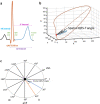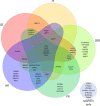Genetic architecture of spatial electrical biomarkers for cardiac arrhythmia and relationship with cardiovascular disease
- PMID: 36918541
- PMCID: PMC10015012
- DOI: 10.1038/s41467-023-36997-w
Genetic architecture of spatial electrical biomarkers for cardiac arrhythmia and relationship with cardiovascular disease
Abstract
The 3-dimensional spatial and 2-dimensional frontal QRS-T angles are measures derived from the vectorcardiogram. They are independent risk predictors for arrhythmia, but the underlying biology is unknown. Using multi-ancestry genome-wide association studies we identify 61 (58 previously unreported) loci for the spatial QRS-T angle (N = 118,780) and 11 for the frontal QRS-T angle (N = 159,715). Seven out of the 61 spatial QRS-T angle loci have not been reported for other electrocardiographic measures. Enrichments are observed in pathways related to cardiac and vascular development, muscle contraction, and hypertrophy. Pairwise genome-wide association studies with classical ECG traits identify shared genetic influences with PR interval and QRS duration. Phenome-wide scanning indicate associations with atrial fibrillation, atrioventricular block and arterial embolism and genetically determined QRS-T angle measures are associated with fascicular and bundle branch block (and also atrioventricular block for the frontal QRS-T angle). We identify potential biology involved in the QRS-T angle and their genetic relationships with cardiovascular traits and diseases, may inform future research and risk prediction.
© 2023. The Author(s).
Conflict of interest statement
B.M.P serves on the Steering Committee of the Yale Open Data Access Project funded by Johnson & Johnson. D.C has received speaker fees from BMS/Pfizer and Servier, and consultation fees from Roche Diagnostics and Trimedics. U.S received consultancy fees or honoraria from Università della Svizzera Italiana (USI, Switzerland), Roche Diagnostics (Switzerland), EP Solutions Inc. (Switzerland), Johnson & Johnson Medical Limited, (United Kingdom), Bayer Healthcare (Germany). D.O.M.-K is a part time research consultant at Metabolon, Inc. U.S is co-founder and shareholder of YourRhythmics BV, a spin-off company of the University Maastricht. The remaining authors declare no competing interests.
Figures







Similar articles
-
Sex hormones and reproductive factors with cardiac arrhythmia and ECG indices: a mendelian randomization study.BMC Cardiovasc Disord. 2024 Nov 20;24(1):659. doi: 10.1186/s12872-024-04335-7. BMC Cardiovasc Disord. 2024. PMID: 39567890 Free PMC article.
-
Spatial QRS-T Angle and Cognitive Decline in Older Subjects.J Alzheimers Dis. 2019;67(1):279-289. doi: 10.3233/JAD-180633. J Alzheimers Dis. 2019. PMID: 30584139
-
Genetic analyses of the electrocardiographic QT interval and its components identify additional loci and pathways.Nat Commun. 2022 Sep 1;13(1):5144. doi: 10.1038/s41467-022-32821-z. Nat Commun. 2022. PMID: 36050321 Free PMC article.
-
Multi-ancestry GWAS of the electrocardiographic PR interval identifies 202 loci underlying cardiac conduction.Nat Commun. 2020 May 21;11(1):2542. doi: 10.1038/s41467-020-15706-x. Nat Commun. 2020. PMID: 32439900 Free PMC article.
-
The spatial QRS-T angle: implications in clinical practice.Curr Cardiol Rev. 2013 Aug;9(3):197-210. doi: 10.2174/1573403x113099990031. Curr Cardiol Rev. 2013. PMID: 23909632 Free PMC article. Review.
Cited by
-
The impact of common and rare genetic variants on bradyarrhythmia development.Nat Genet. 2025 Jan;57(1):53-64. doi: 10.1038/s41588-024-01978-2. Epub 2025 Jan 2. Nat Genet. 2025. PMID: 39747593 Free PMC article.
-
Genomic and molecular evidence that the lncRNA DSP-AS1 modulates Desmoplakin expression.medRxiv [Preprint]. 2025 Mar 31:2025.03.29.25324867. doi: 10.1101/2025.03.29.25324867. medRxiv. 2025. Update in: Hum Genet. 2025 Jul 30. doi: 10.1007/s00439-025-02761-x. PMID: 40236443 Free PMC article. Updated. Preprint.
-
Latent profiles of global electrical heterogeneity: the Hispanic Community Health Study/Study of Latinos.Eur Heart J Digit Health. 2024 Jul 8;5(5):611-621. doi: 10.1093/ehjdh/ztae048. eCollection 2024 Sep. Eur Heart J Digit Health. 2024. PMID: 39318685 Free PMC article.
-
Sex hormones and reproductive factors with cardiac arrhythmia and ECG indices: a mendelian randomization study.BMC Cardiovasc Disord. 2024 Nov 20;24(1):659. doi: 10.1186/s12872-024-04335-7. BMC Cardiovasc Disord. 2024. PMID: 39567890 Free PMC article.
-
Applying multimodal AI to physiological waveforms improves genetic prediction of cardiovascular traits.Am J Hum Genet. 2025 Jul 3;112(7):1562-1579. doi: 10.1016/j.ajhg.2025.05.015. Epub 2025 Jun 20. Am J Hum Genet. 2025. PMID: 40543505 Free PMC article.
References
-
- Young, W. et al. Comparisons of the spatial QRS-T angle with intra-cardiac markers of depolarization and repolarization. Comput. Cardiol. 2020 Computing in Cardiology, Rimini, Italy, pp. 1–4 (2020).
Publication types
MeSH terms
Substances
Grants and funding
- CH/1992001/6764/BHF_/British Heart Foundation/United Kingdom
- MR/N025083/1/MRC_/Medical Research Council/United Kingdom
- MR/R017468/1/MRC_/Medical Research Council/United Kingdom
- R01 HL105756/HL/NHLBI NIH HHS/United States
- R01 HL118277/HL/NHLBI NIH HHS/United States
- K24 HL148521/HL/NHLBI NIH HHS/United States
- T32 HL139439/HL/NHLBI NIH HHS/United States
- MC_PC_20029/MRC_/Medical Research Council/United Kingdom
- R01 HL142825/HL/NHLBI NIH HHS/United States
- R01 HL141989/HL/NHLBI NIH HHS/United States
- R01 HL138737/HL/NHLBI NIH HHS/United States
- MC_UU_00007/10/MRC_/Medical Research Council/United Kingdom
- D43 TW007393/TW/FIC NIH HHS/United States
- R56 HL118277/HL/NHLBI NIH HHS/United States

